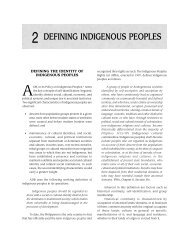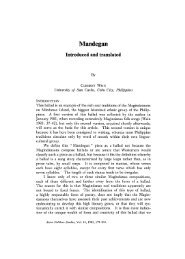PHILIPPINES RATTAN VALUE CHAIN STUDY - Aboutphilippines
PHILIPPINES RATTAN VALUE CHAIN STUDY - Aboutphilippines
PHILIPPINES RATTAN VALUE CHAIN STUDY - Aboutphilippines
You also want an ePaper? Increase the reach of your titles
YUMPU automatically turns print PDFs into web optimized ePapers that Google loves.
2.7 EVALUATING VERTICAL INCOME AND PROFITTable 3 presents the vertical distribution of income and profit, as well as the relative numbers of market actorsin the rattan sector of the Philippines.Table 3: Income and ProfitVertical distribution of income and net profits based on cash costs, not including labor and opportunity costs of laborGroups DirectlyInvolvedAnnual Sales perParticipantGroup(millions of pesos)Size Low HighAverage Net Profit, perYear per Participant(millions of pesos)Individual gatherers 56,000 0 0.02 0.01(no cash investment,labor only)Distribution within GroupSkewed (10 percent illegalgatherers operate year-round; 90percent legal gatherers operate 4months)Kapatas 190 1.44 4.32 0.09 Fairly evenly distributedPOs (CBFM, CADC,negotiated RCC)168 0 1.75 0.02 Fairly evenly distributedPermittees 450 0.88 7.01 0.04 Fairly evenly distributedProvincial traders 190 0.40 1.98 0.12 Fairly evenly distributedNational traders 174 3.19 12.78 1.46 Fairly evenly distributedRetailers 105 0.03 0.15 0.04 Fairly evenly distributedManufacturing andexporting firms15,000 119.45 298.62 27.97 Skewed (60 percent earn lessthan 22.5 million pesos).2.8 EVALUATING HORIZONTAL INCOME AND PROFITAlthough income in rattan gathering is generally low among all community groups, the research of Gatmaytan2 indicated that differences in income exist even among the same horizontal earners. For instance, theMangyan-Alangan of Mindoro are paid between P6 to P14 3 per pole, whereas the upland producers in Samarare being paid higher or between P7 to P16 per pole.The factor that greatly influences income, however, is the permit to cut rattan. For example, the Mangyan-Alangans are not selling rattan poles due to a delay in renewal of their permit that dragged on for more than ayear. They then found out that an illegal group was able to get a bogus permit and operate in their area. Theirony of cases such as this is that illegal poachers may have better access to regular income than those whopossess legal rights to use the forest resources.For the traders, both local and national, income is fairly evenly distributed. Manufacturers are more inclinedto buy raw materials that are just enough for their production needs. The purchases may be minimal, albeitconstant. These buyer-seller relationships, however, are long term, thus, the income of the traders is morestable, but depends on the manufacturer’s performance. Each trader maintains about three buyers.The distribution of income among manufacturers, in contrast, is skewed in favor of the large firms, whichcomprise about 10 percent of the 15,000 registered firms. Their size gives them the ability to market theirproducts abroad. The size of investment is also a source of different income levels across the industry. Someof the large firms, however, also subcontract production to SMEs.2Augusto B. Gatmaytan. 2004 “Case Studies in Rattan Utilization in Ancestral Domain Areas”, Quezon City, Philippines.3Philippine pesos. Unless otherwise noted, all figures in pesos are Philippine in this document.FRAME: <strong>PHILIPPINES</strong> <strong>RATTAN</strong> <strong>VALUE</strong> <strong>CHAIN</strong> <strong>STUDY</strong> 9
















